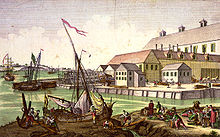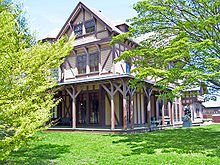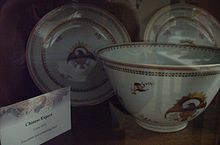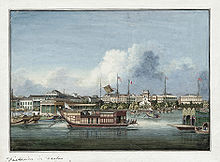- Old China Trade
-
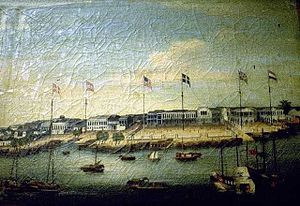 Thirteen Factories, the Canton (Guangzhou) area where the first foreign trade was allowed in the 18th-century
Thirteen Factories, the Canton (Guangzhou) area where the first foreign trade was allowed in the 18th-century
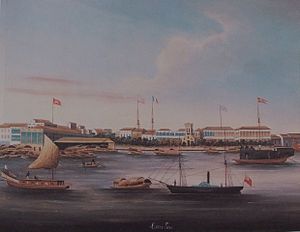 a 1850-60s painting showing flags of that era's trading nations, Great Britain then ranking first in number of ships and tonnage in chinese ports, followed by the US, Hamburg (flag on the left) and Denmark
a 1850-60s painting showing flags of that era's trading nations, Great Britain then ranking first in number of ships and tonnage in chinese ports, followed by the US, Hamburg (flag on the left) and Denmark
The Old China Trade was the name given to the early commerce between the Qing Empire and the United States under the Canton System, spanning from shortly after the end of the American Revolutionary War in 1783 to the Treaty of Wanghsia in 1844. The Old China Trade represented the beginning of relations between the United States and East Asia, including eventually U.S.–China relations. The Maritime Fur Trade was a major aspect of the Old China Trade.
Contents
Origins
The Second Treaty of Paris in 1783 ceased Anglo-American hostilities after the American Revolutionary War and subsequently freed American trade from British control. Unsurprisingly, American merchants exploited their newfound liberty, eagerly hunting all over the world for new ways to make a profit. Unfortunately for the Americans, the British, not wanting their former colonies to become a new rival in the already-existing Atlantic trade, had effectively closed their remaining Atlantic colonies, as well as those of other European nations, to American merchant vessels; British harassment or seizure of American ships trading with European Atlantic colonies was common. As a result, the American traders, now deprived of a trade that had been so essential to the American colonies before, were forced to search for ports that were less European-dominated. In their searches, they found the Chinese market.
Trade with China was by no means a new trend: since the voyage of Marco Polo and the days of the Silk Road, the Chinese had established a tradition of trade with the West. Therefore, by the time the Empress of China, the first American merchant ship to reach China, arrived in Canton in 1784, China was already engaging in an active trade with the British at Canton and the Portuguese at Macau. However, China, while having firm relations with Europe, was not dominated by it as the ports of the Caribbean and Atlantic were; therefore, it was an opportune destination for American merchants to establish a new trading route. For the most part, the Chinese allowed them to do so.
Upon realizing that America was its own sovereign nation, the Chinese were convinced that the Americans would not interfere with pre-existing Anglo-Chinese trade agreements since American businessmen arrived as private traders without representation from the American government. This relatively open yet somewhat indifferent attitude towards American traders allowed them to gain a grip on the Chinese market.
Growth
John N. A. Griswold House, built in 1864 for an American China trade merchant in Newport, Rhode Island
Trade with China, originally merely a prospect—not to mention a risky venture—was soon not only realized but also proven to be extremely lucrative. American traders, now with a stable foothold in Canton, were eager to sell their goods to China; the extravagant mandarins in China, in turn, were excited to buy these goods. The first item that tended to sell in China was Spanish bullion: American traders would devote large sums of money to buying and amassing large quantities of specie for export to China. Bullion was primarily used to complement the less profitable American goods such as cheese, grain, and rum. Use of bullion eventually became considerable: over $62 million worth of specie was traded to China between 1805 and 1825. This practice, however, gradually declined after 1815, when American merchants began to participate in “chain trade” routes—buying and selling goods en route to Canton. The second major—and by far the most lucrative—American export to China was ginseng. Hailed by the Chinese as a panacea, the most potent and therefore most demanded type of ginseng, aralia quinquefolia, grew in Manchuria and the Appalachian Mountains. Ginseng would be transported from the interiors of Pennsylvania and Virginia to Philadelphia, New York, or Boston, at which point it would be shipped to China and sold for up to 250 times its weight in silver. Furs were the third-most lucrative American export to China. Searching for another type of item that could be sold to the Chinese aside from specie and ginseng, Americans soon found that the mandarins had a taste for sea otter pelts, which could be inexpensively purchased from the Indians of the northwest coast of America and shipped to Canton. The Chinese mandarins’ desire for bullion, ginseng, and furs was the primary impetus for America’s initiation of trade with China: seeing the Empress of China, which had carried all three goods, returning to America rich in 1785 inspired other Americans to make similar voyages. Reasons for maintaining the China trade, however, were different.
There had always been a general American desire for foreign and sometimes exotic wares, and, with the British conglomerates (namely the East India Company) no longer dominating American trade, the job of satisfying this want fell to the American merchants. Therefore, when the Empress returned home, she brought with her a large stock of outlandish Chinese goods, which her owners sold for a significant profit of $30,000—a 25% gain. Other American merchants did not take long in realizing that, while selling American specie, ginseng, and fur to the Chinese mandarins was undoubtedly profitable, selling Chinese goods in America was considerably more so. Further motivation came from the knowledge that China, as a whole, had a mercantilist-like attitude towards foreign commerce; they tended to resist the importation of foreign goods because of a mixture of the Confucian doctrine, which deprecated it, and the underlying ethnocentrism felt by the Chinese—that they did not need to actively search for trade because the inferior white barbarian states would instinctively bring it to them as a form of tribute[citation needed]. Because of these factors, American traders began to focus their funds on acquiring Chinese goods—a practice that the Chinese were more willing to adopt—rather than on purchasing those of America. What resulted was the flooding of Chinese teas, cottons, silks, rhubarb, cassia, nankeens (durable, yellow cloth), floor-matting, lacquerware, fans, furniture, and porcelains, into America, to the extent that even those of poor social classes possessed some Chinese items—perhaps a painting of Canton harbor or a pair of trousers made out of nankeen cloth.
End
At the end of the First Opium War in 1842, Britain and China signed the Treaty of Nanking, which effectively overthrew the original mercantilist system by means of forcing open the ports of Canton, Amoy, Foochow, Ningpo, and Shanghai to British trading. Seeing that Britain could easily eliminate foreign competition in China with its new privileges and considerable trading prowess, Americans found the need to reestablish their diplomatic relations and commercial equality in China; for the past fifty-nine years, Americans had been interacting with China merely through their business transactions, without government-to-government communication. As a result, the administration of President John Tyler sent the commissioner Caleb Cushing to negotiate a treaty in which America would receive the same privileges as Britain. Cushing, in the Treaty of Wanghsia in 1844, not only achieved this goal but also won the right of extraterritoriality, which meant that Americans accused of crimes in China were to be tried by American courts only. This treaty was monumental in that it laid the foundation for a more extensive and regulated American trade with China; American ships would no longer make the sporadic—and somewhat reckless—voyages to China so characteristic of the Old China trade.
Noted China Trade merchants
- William Henry Aspinwall
- George Cabot
- John Perkins Cushing
- Elias Hasket Derby
- Fanning & Coles
- John Murray Forbes
- Robert Bennet Forbes
- Charles W. King
- Gideon Nye
- Joseph Peabody
- Thomas Handasyd Perkins
- Russell Sturgis
- John Renshaw Thomson
- William Shepard Wetmore
- Abiel Abbot Low
See also
- Foreign relations of Imperial China
- History of the west coast of North America
- Paul Jones (1843 ship)
References
- Dudden, Arthur Power. The American Pacific: From the Old China Trade to the Present. New York: Oxford University Press, 1992.
- Dulles, Foster Rhea. The Old China Trade. Cambridge: The Riverside Press, 1930.
- Goldstein, Jonathan. Philadelphia and the China Trade, 1682–1846: Commercial, Cultural, and Attitudinal Effects. Philadelphia: Pennsylvania State University Press, 1978.
- Lee, Jean Gordon. Philadelphians and the China Trade, 1784–1844. Philadelphia: Philadelphia Museum of Art, 1984.
External links
Further reading
- Forbes, Robert Bennet (1844). Remarks on China and the China Trade. Boston: Samuel N. Dickinson, printer. http://books.google.com/books?id=TDEaAAAAYAAJ&pg=PA46&dq=lintin+ship&lr=&num=100&as_brr=1&cd=9#v=onepage&q=lintin%20ship&f=false.
Categories:- History of foreign trade in China
- China–United States relations
- Foreign trade of the United States
- Economic history of the United States
Wikimedia Foundation. 2010.

